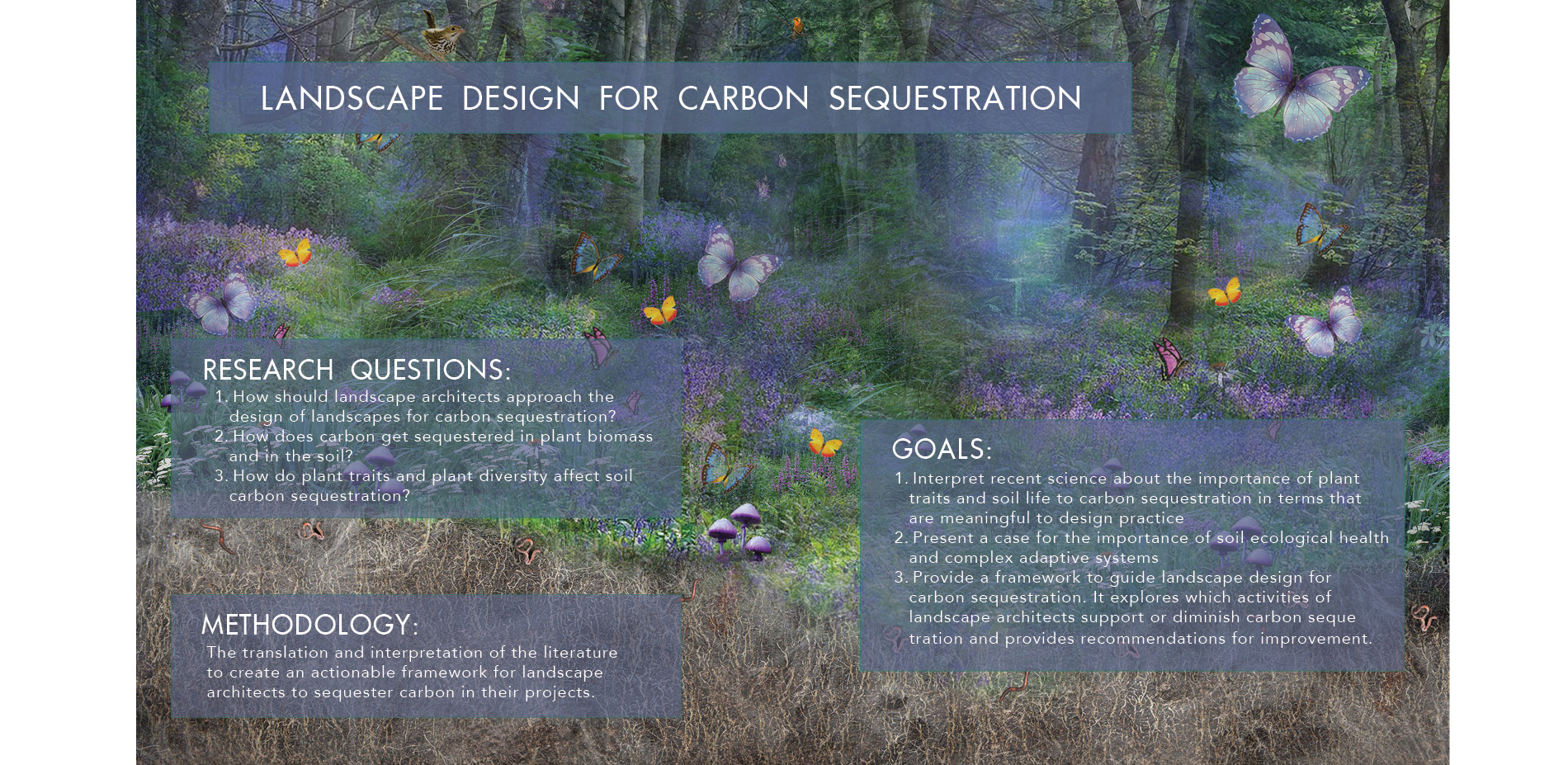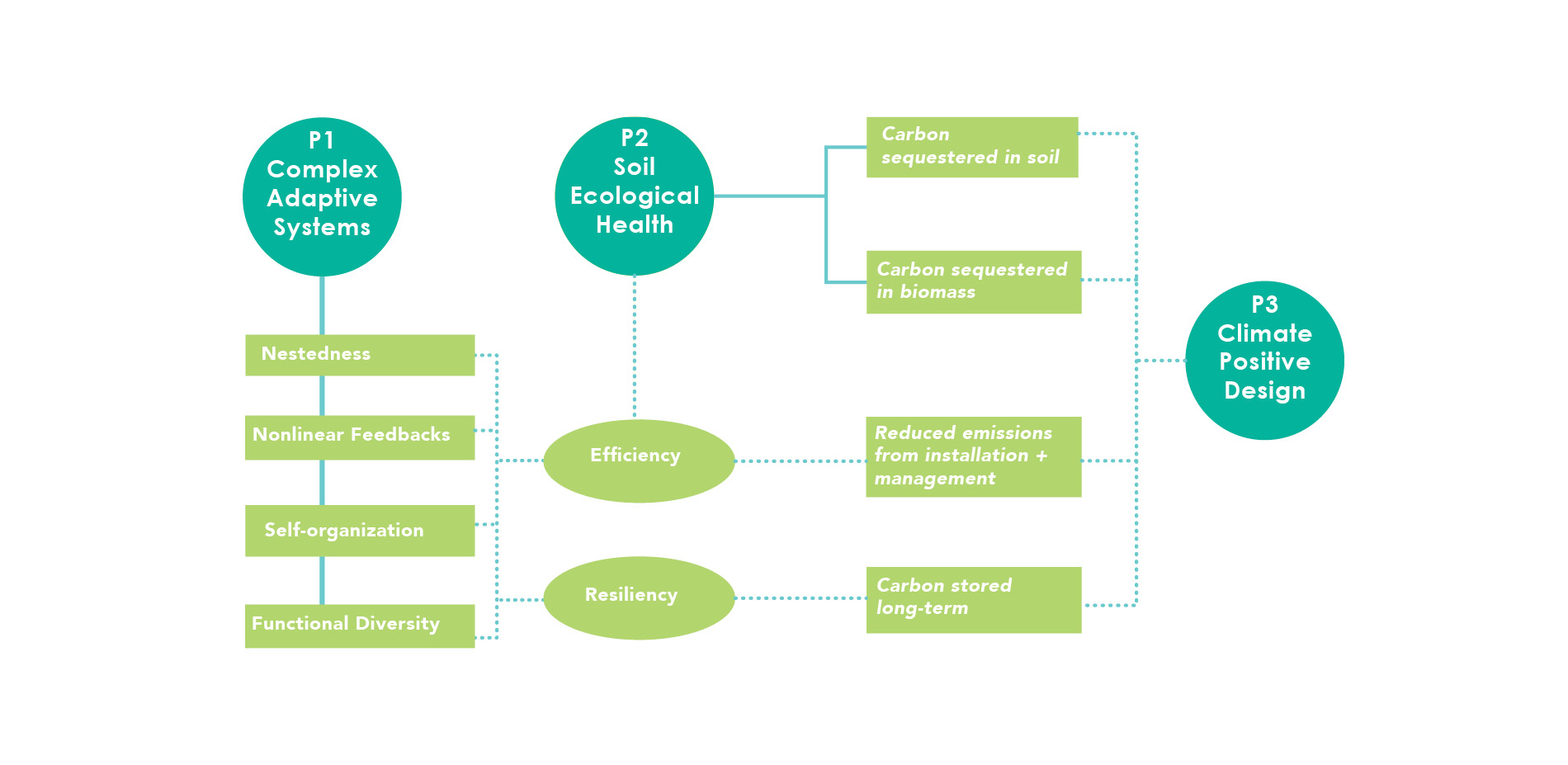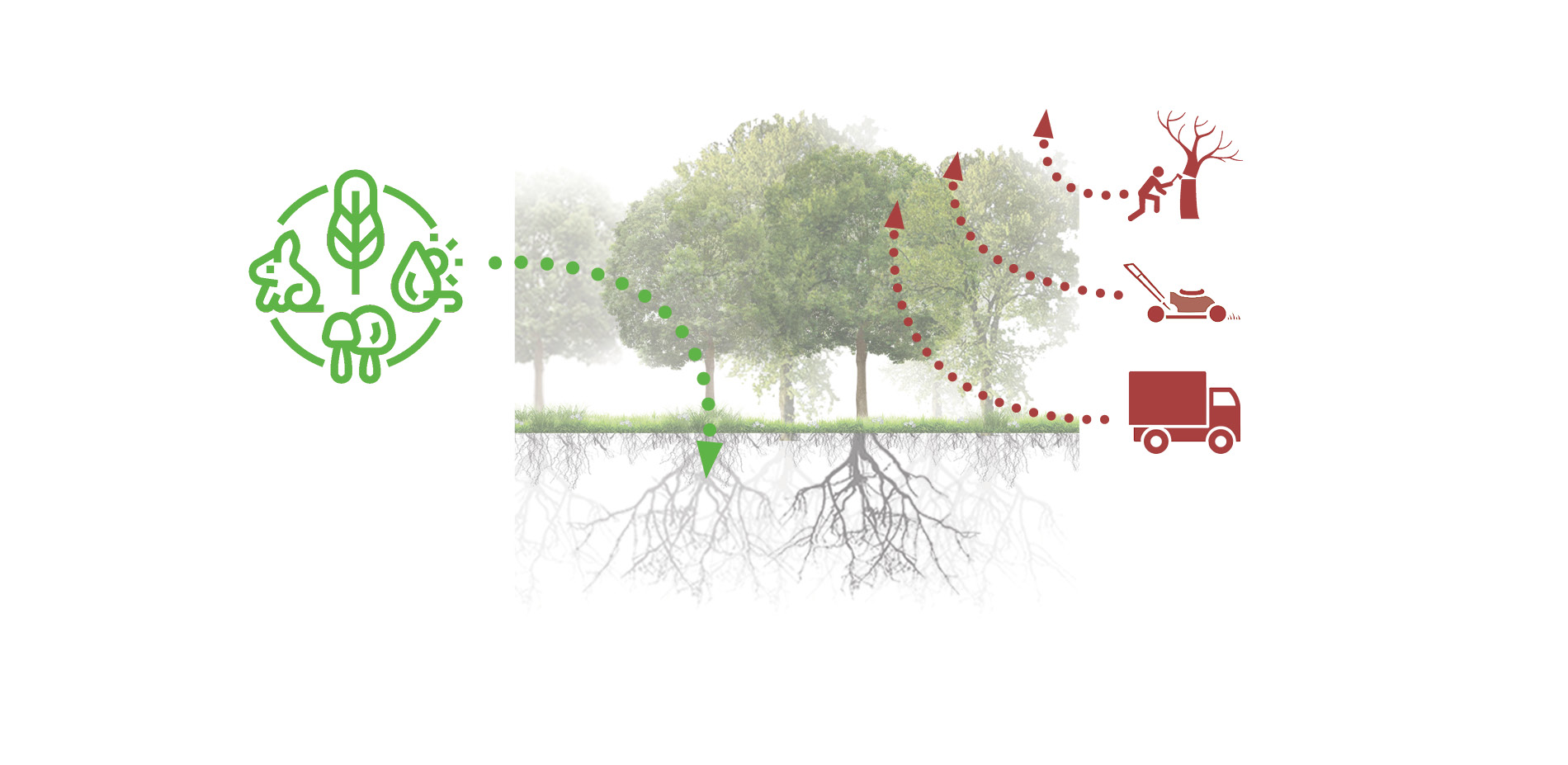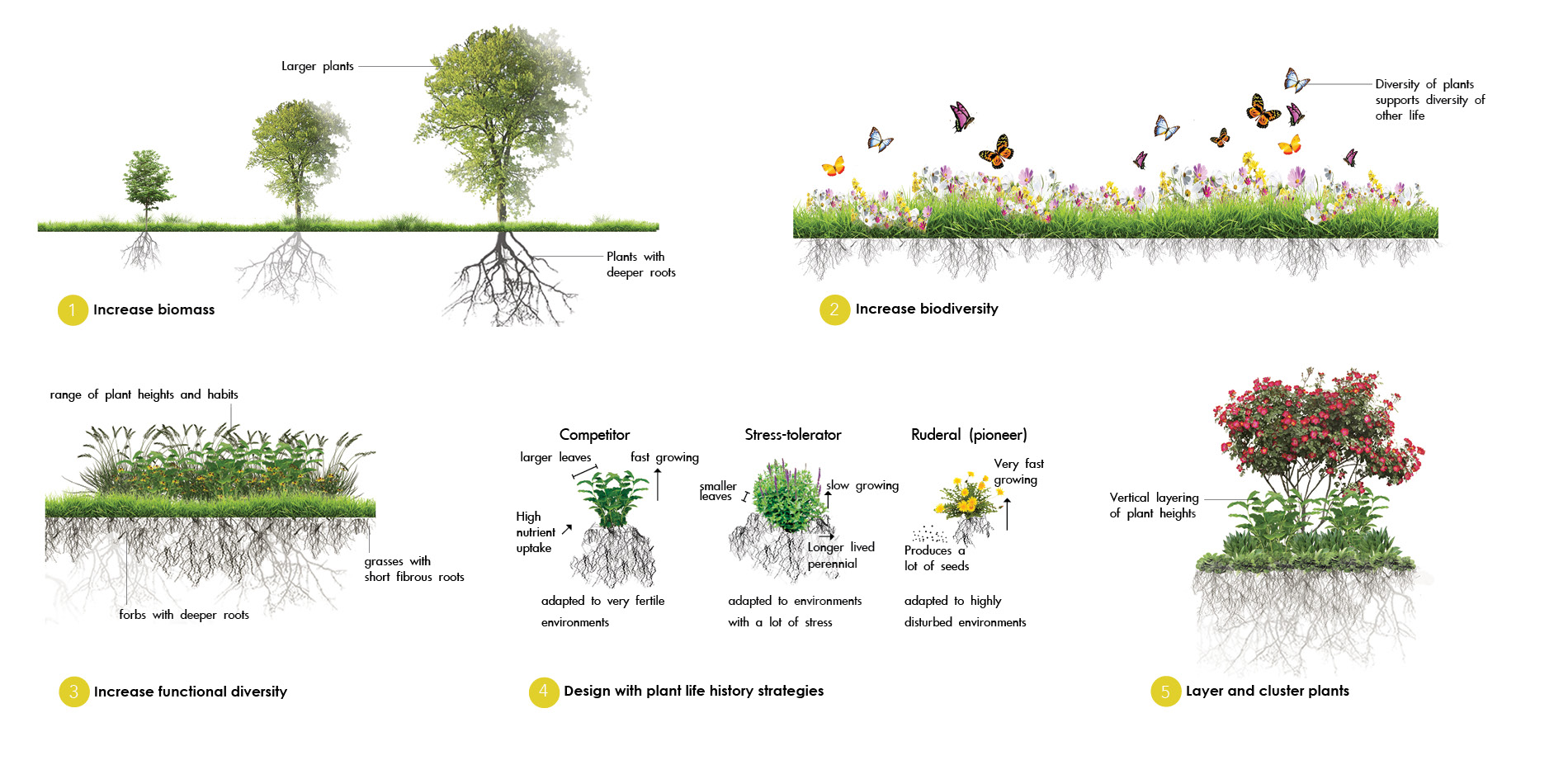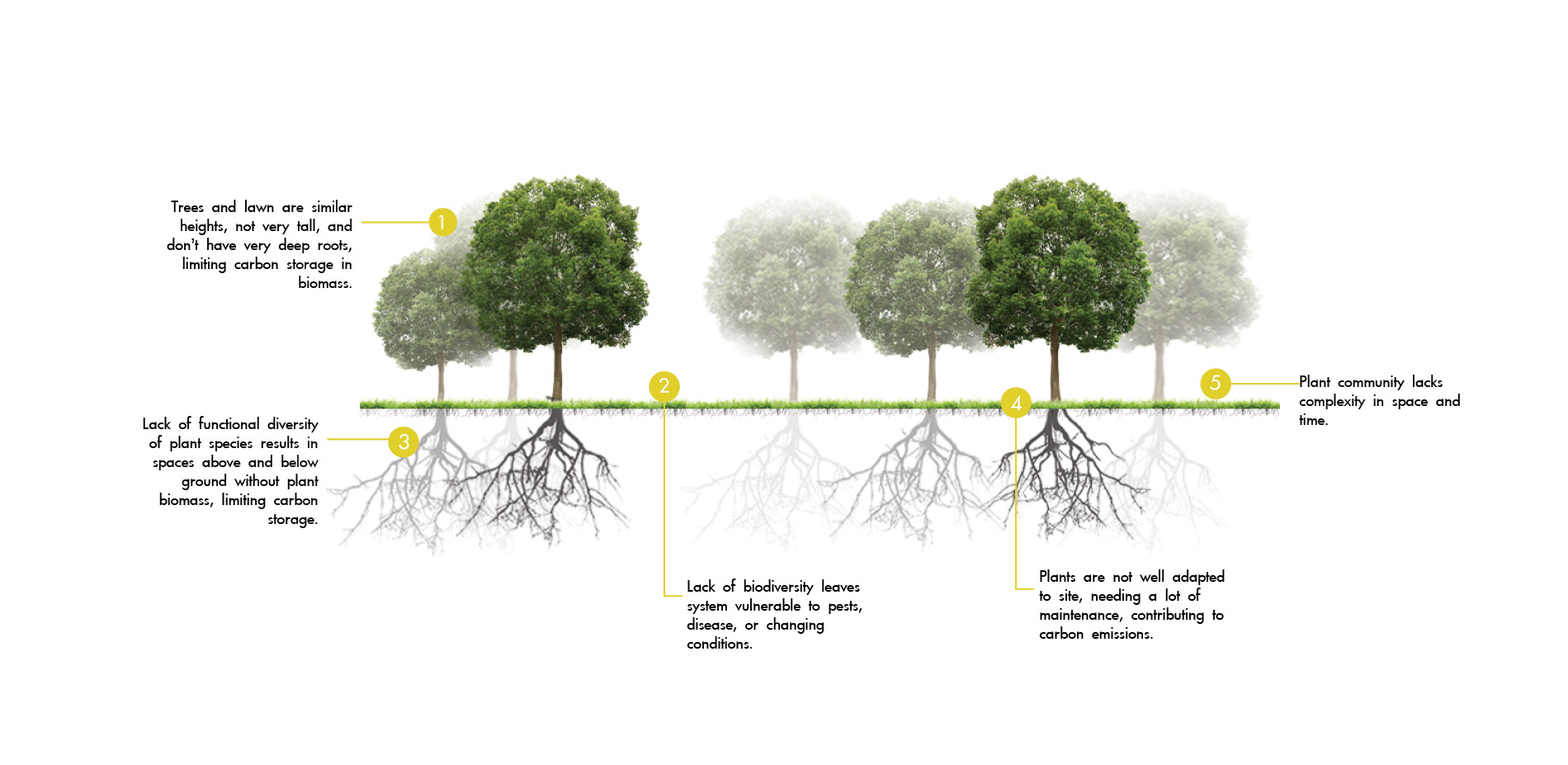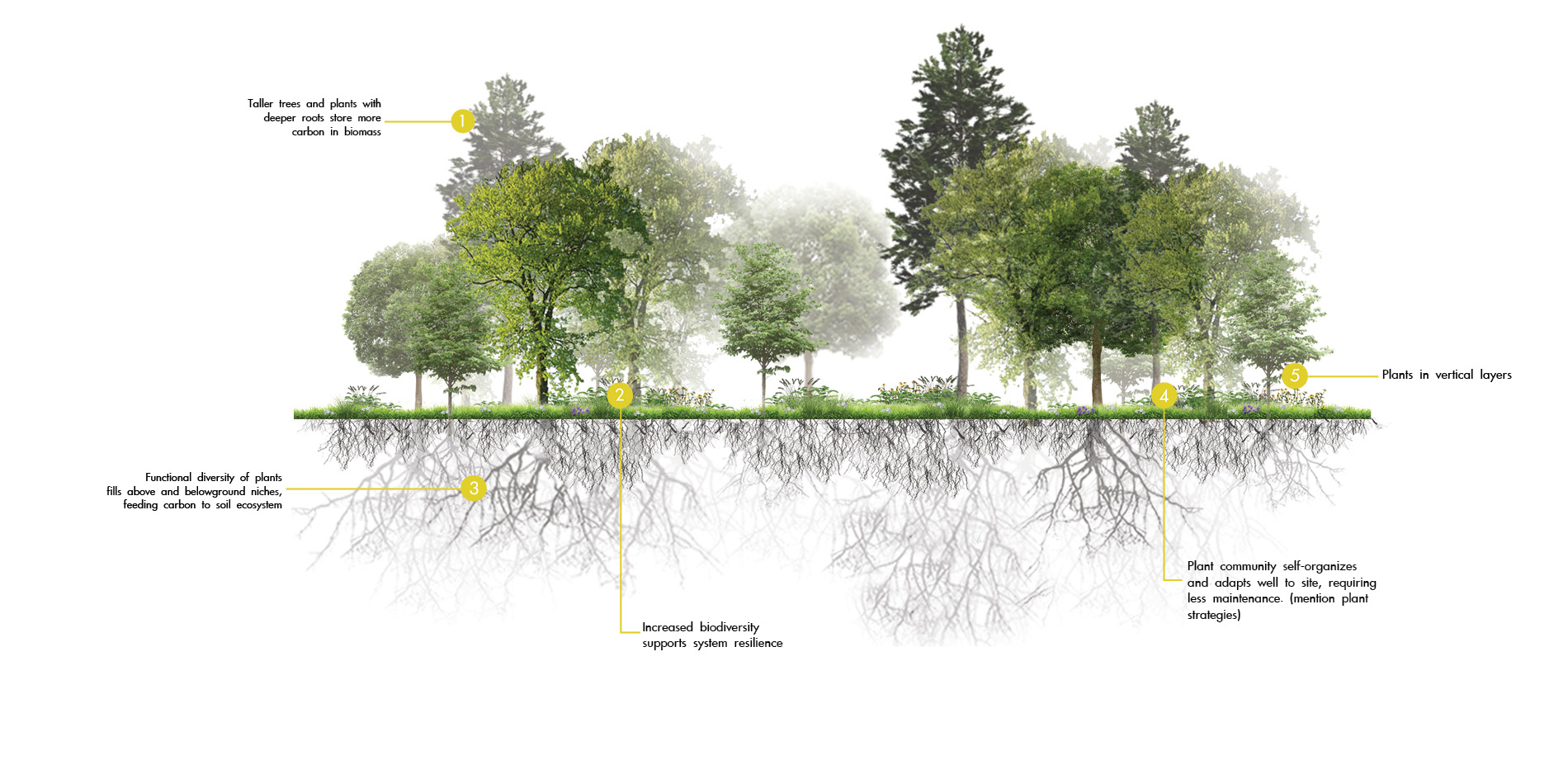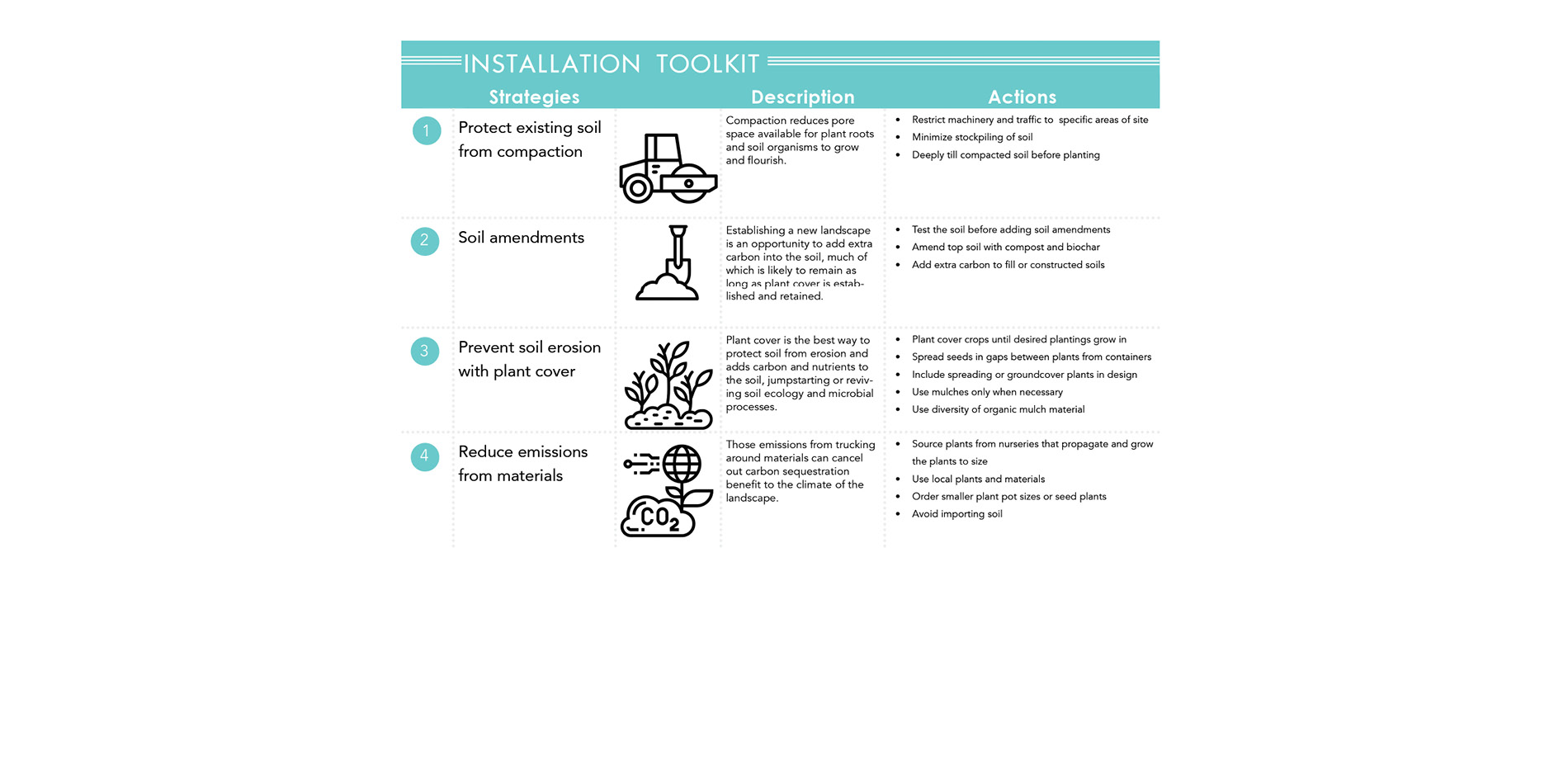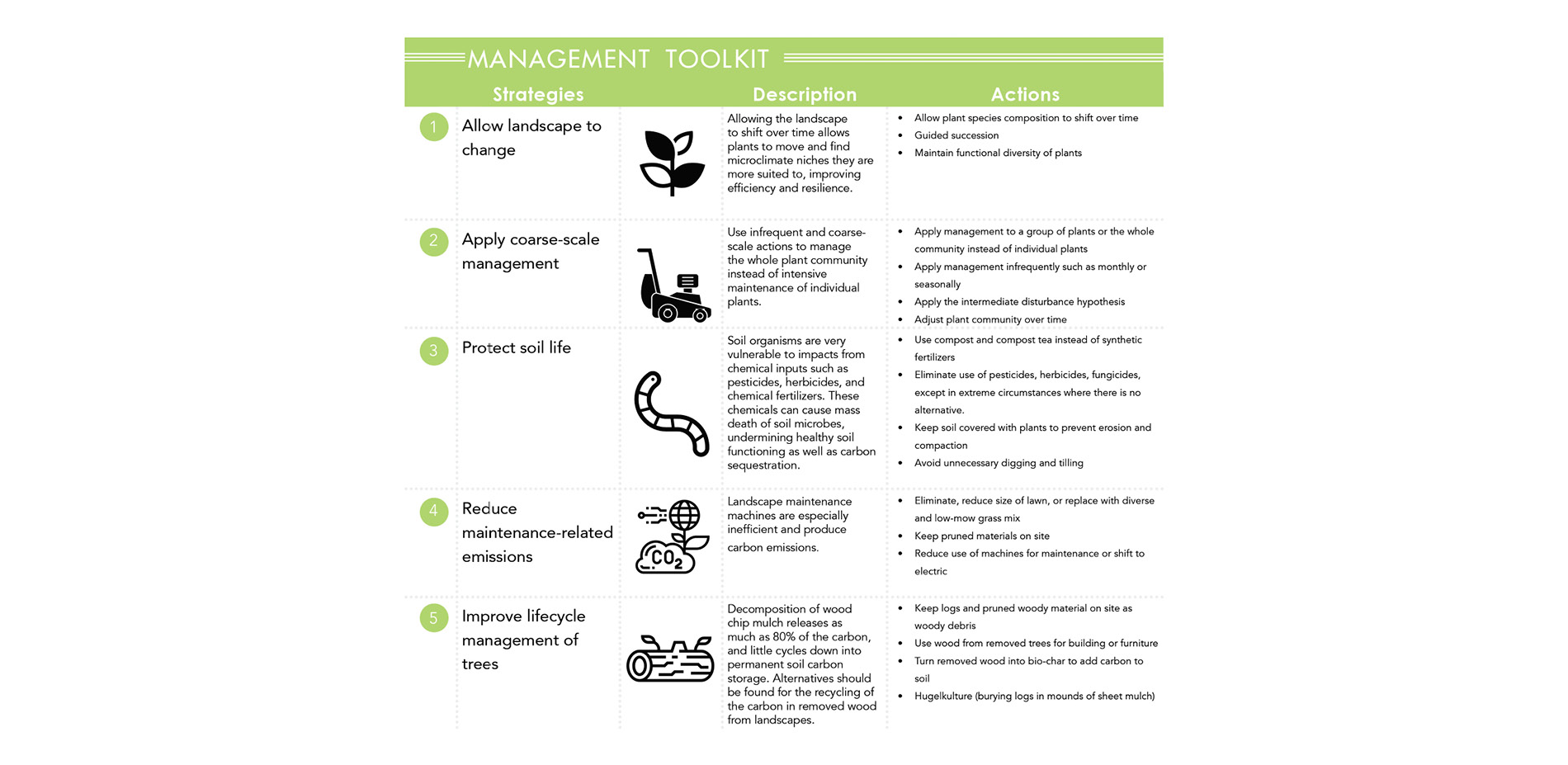Landscape Design for Carbon Sequestration
Honor Award
Research
Deanna Lynn, Student ASLA
Faculty Advisors: Bart Johnson
University of Oregon
The authors of this project filled an important gap in the existing research on carbon sequestration—namely, the potential use of soil to proactively remove carbon dioxide from the atmosphere. With the goal of providing a template for climate-positive design through improved soil health, this study proposes strategies to increase biodiversity with layers of plants. Accompanying toolkits with legible graphics and clear descriptions allow these ideas to be put into practice.
- 2020 Awards Jury
Project Credits
Associate Professor, University of Oregon
Krista McGuire
Project Statement
Landscape architects have the potential to contribute to climate change mitigation through natural climate solutions that sequester carbon in ecosystems. However, there is a lack of resources for landscape architects on how to design landscapes for carbon sequestration. Specifically, there do not exist any resources to guide how to choose a planting palette for soil carbon sequestration. This project seeks to address these gaps in knowledge by the translation and interpretation of scientific literature to create an actionable framework for landscape architects to sequester carbon in their projects. The framework consists of principles, strategies, and actions for design, installation, and management of landscapes for carbon sequestration. A key finding is that increasing the functional diversity of plants increases the potential carbon sequestration of the landscape by increasing its productivity and resilience. Additionally, functional diversity of plants supports the soil microbial ecosystem that is key to long-term soil carbon storage. This framework emphasizes that designing landscapes for carbon sequestration should prioritize belowground carbon dynamics and the functioning of the whole landscape system.
Project Narrative
NATURAL CLIMATE SOLUTIONS
Climate change is widely acknowledged to threaten the well-being of human and natural systems. At this point, cutting emissions is not enough to keep warming under 1.5 degrees; removing carbon dioxide from the atmosphere is necessary (IPCC 2018). Natural Climate Solutions, or the sequestration of carbon in natural systems, is the only currently feasible solution with positive co-benefits for human and natural systems. Natural Climate Solutions have the potential to mitigate up to 21% of US emissions each year (Fargione et al. 2018). In the context of natural climate solutions, “carbon sequestration” in this project refers to the biological process where plants take carbon dioxide out of the atmosphere through photosynthesis, store the carbon in their tissues, and send carbon through roots to the soil, where it can be stored long-term.
PROJECT SCOPE AND SIGNIFICANCE
Natural Climate Solutions are being implemented in fields such as regenerative agriculture, but are not yet a priority for the field of landscape architecture. Some reasons for this may be the complexity of the science of carbon sequestration, lack of research on carbon sequestration in urban areas, difficulty in scaling up the impact of site-scale decisions, and lack of policy and funding for such projects.
Current tools available for landscape architects, such as i-Tree or CMG’s Pathfinder app, only incorporate estimations of potential sequestration in biomass (above and belowground live plant parts); they do not address potential carbon sequestration in the soil. Although these tools are a step in the right direction, there do not exist any resources for landscape architects on how to design and choose plants for increased soil carbon sequestration based on scientific evidence.
This project addresses this gap in knowledge and resources by interpreting the recent scientific literature on plant traits, soil life, and carbon sequestration in terms that are meaningful to design practice; presenting a case for the importance of soil ecological health and complex adaptive systems; and providing a framework to guide landscape design for carbon sequestration. My methodology focused on translating and interpreting the literature to create an actionable framework for landscape architects to sequester carbon in their projects.
THE FRAMEWORK
The framework I’ve developed consists of three principles that inform sets of strategies and actions for design, installation, and management of landscapes for carbon sequestration. The principles are complex adaptive systems, soil ecological health, and climate positive design. The strategies and actions are formulated to increase the potential carbon input by photosynthesis, and to create a diverse and efficient system that cycles carbon down into long-term storage in the soil, preventing it from release.
COMPLEX ADAPTIVE SYSTEMS
Characteristics of complex adaptive systems relevant to landscape design for carbon sequestration include functional diversity, self-organization, nonlinear feedbacks, and nestedness. Plant-soil feedbacks, such as the movement of carbon through mycorrhizal fungi, contribute to the complexity, efficiency, and resilience of the system, supporting increased carbon sequestration.
Functional diversity in an ecosystem is defined as the degree of variation in functional traits among organisms in a community (Garnier et al. 2016). Increasing the functional diversity of plants increases the potential carbon sequestration of the plant community. By increasing the range of plant traits represented, the plant community fills more niches and supports more diversity of life in the soil (Conti and Díaz 2013; Milcu et al. 2014; Weisser et al. 2017; Faucon et al. 2017; Yang et al. 2019; Lange et al. 2015). Functional diversity facilitates the self-organization of complementary types of organisms into interconnected communities, leading to increased system efficiency and resilience. More functional diversity leads to more complex interactions such as nonlinear feedbacks that can buffer a system against potential shocks (Gunderson 2000; Levin et al. 2013). A more resilient ecosystem is better at protecting stores of carbon in biomass and soil over a longer period of time, preventing it from being released back to the atmosphere.
SOIL ECOLOGICAL HEALTH
Healthy soil contains a huge abundance and diversity of life. Soil microbes are key to the soil ecosystem’s functioning, and contribute to the soil’s capacity to retain nutrients, hold water, filter pollutants, and sequester carbon. Carbon in ecosystems exists in the biomass of all organisms and in dead organism biomass, and is constantly cycling around when organisms consume each other, consume each other’s waste, or consume dead biomass. The most significant pathway for carbon to enter the soil is through the root-mycorrhizal fungal network, which facilitates carbon sequestration and storage through root and hyphae exudates, turnover, and formation and stabilization of soil aggregates that protect organic matter from decomposition (Frey et al. 2019, Jones et al. 2009, Schmidt et al. 2011). The microbial life in the soil is absolutely critical to carbon sequestration, and landscape architects can best nurture soil life by designing a continuous cover of a diversity of plants.
CLIMATE POSITIVE DESIGN
Climate Positive Design is a term borrowed from CMG landscape architecture’s iniative of that name. For a landscape to sequester carbon from the atmosphere in a way that mitigates climate change, the flux of carbon in and out of the system needs to be net positive–meaning more carbon is sequestered in biomass and soil than is lost from the system due to respiration and emissions. Human activities should be conceptualized as part of the whole landscape system, especially when considering carbon fluxes. It is essential that landscape architects consider any emissions resulting from their actions that may cancel out the climate benefit of designing for carbon sequestration.
DESIGN STRATEGIES
Design for carbon sequestration should incorporate soil and belowground processes. In temperate climates, there is more carbon in most ecosystems belowground than aboveground. Additionally, carbon in the soil is more likely to be stored long-term than carbon aboveground in biomass. I developed these strategies to increase potential carbon sequestration both above and belowground. Designers should incorporate all strategies into the landscape design; however which actions are appropriate depends on the target ecosystem or vegetation type and the overall design goals.
Current tools available to landscape architects only capture the potential sequestration in biomass, not in the soil. From my research, it is not feasible to quantify and rank plant species according to their soil carbon sequestration potential. This is because the ecological interactions and feedbacks between plants and soil are so complex. The amount of carbon that plants send belowground is highly variable depending on the climate, soil type, soil ecological health, and other environmental and ecological factors. Although it is not feasible to quantify the soil carbon sequestration of plant species designers can choose plants based on their potential to work together as a carbon-sequestering designed ecosystem.
The design strategies are based on my literature review connecting specific plant traits to increased carbon sequestration. Plant functional traits have an important effect on soil properties such as increased soil structural stability, reduction of soil erosion, nutrient availability, abundance of pathogens, and soil carbon sequestration (Faucon et al. 2017). Including plants with traits such as deeper roots or more fibrous roots directly supports increased carbon sequestration (Rillig et al. 2015; Demenois et al. 2018).
INSTALLATION AND MANAGEMENT
Installation is a critical time to start a landscape on a trajectory towards functional diversity, self-organization, and resilience. To do this, it is important to protect soil health from compaction and erosion, to add additional carbon to the soil through compost and bio-char, and to reduce emissions from construction and plant materials.
Adaptive Management accepts the reality that landscapes are dynamic, complex systems that will never stay the same as they were when installed or restored. Human management should adjust to the changing system instead of insisting on maintaining a static state (Gunderson 2000, Dunnett 2004). Management should maintain soil ecological health, and prevent maintenance-related carbon emissions. Adaptive management can help a landscape sequester carbon by ensuring that it maintains high diversity and functionality throughout its life.
